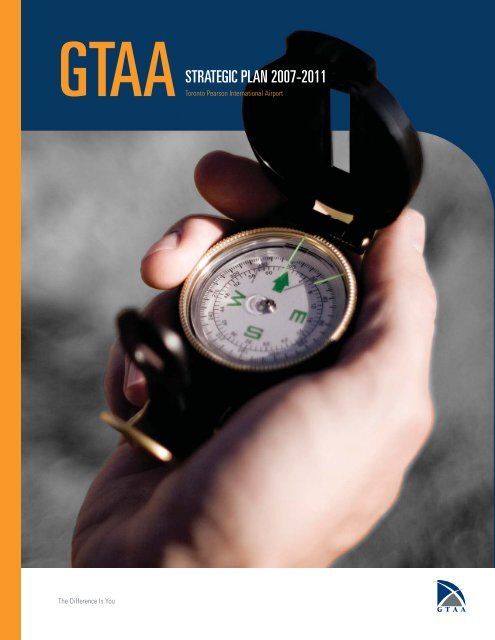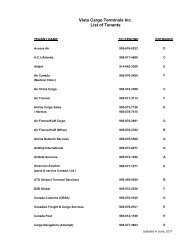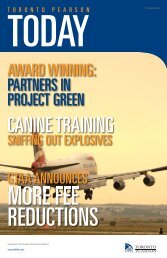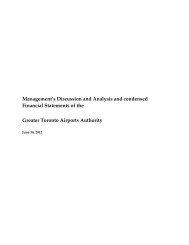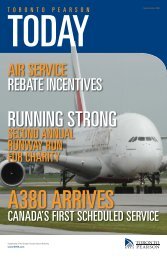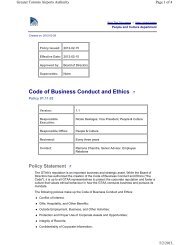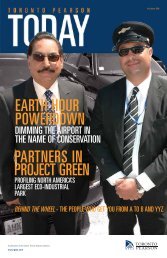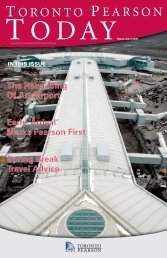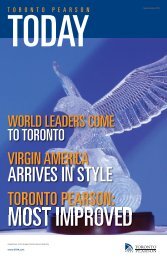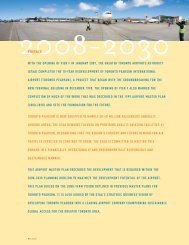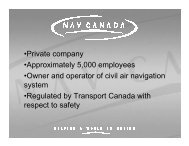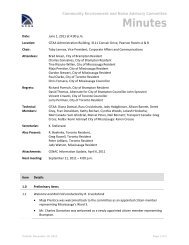Corporate Strategic Plan - Toronto Pearson International Airport
Corporate Strategic Plan - Toronto Pearson International Airport
Corporate Strategic Plan - Toronto Pearson International Airport
You also want an ePaper? Increase the reach of your titles
YUMPU automatically turns print PDFs into web optimized ePapers that Google loves.
GTAA<br />
STRATEGIC<br />
PLAN 2007-2011<br />
<strong>Toronto</strong> <strong>Pearson</strong> <strong>International</strong> <strong>Airport</strong><br />
The Difference Is You
CONTENTS<br />
Introduction 1<br />
The <strong>Strategic</strong> Context 1<br />
The Vision and <strong>Strategic</strong> Themes 2<br />
The Strategy 2<br />
The <strong>Strategic</strong> <strong>Plan</strong>ning Process 3<br />
<strong>Strategic</strong> Outcomes 6<br />
<strong>Plan</strong> Implementation and Review 6<br />
Annual Review and <strong>Plan</strong>ning Cycle 7
INTRODUCTION<br />
The global aviation industry continues to change at an<br />
ever quickening pace. The growth of international commerce<br />
and an improved standard of living in many countries<br />
around the world have led to substantial increases in the<br />
demand for air travel. Air carriers and airports alike have<br />
expanded to meet this demand. Growth has been accompanied,<br />
however, by challenges in the form of rising fuel costs,<br />
continuing security threats, growing environmental concerns<br />
and keen competition for market share.<br />
Over the last decade, we have worked to meet this growth in<br />
air travel demand by modernizing and expanding the infrastructure<br />
of <strong>Toronto</strong> <strong>Pearson</strong> <strong>International</strong> <strong>Airport</strong>. With spacious,<br />
new facilities in place, we are well equipped to deliver<br />
innovative and industry leading services to meet the needs of<br />
our customers and stakeholders. But to make the best use of<br />
our new assets, and to ensure the continued growth of our<br />
business, we must now change our organizational focus from<br />
building to becoming more competitive in all aspects of our<br />
business. Additionally, we will be more aggressive in the pursuit<br />
of new business, and we must change our business<br />
model to ensure a sound and sustainable financial foundation<br />
for the long term.<br />
This <strong>Strategic</strong> <strong>Plan</strong> describes a vision and a balanced strategy<br />
to make us a competitive and sustainable leading airport company<br />
focused on meeting the current and future needs of our<br />
customers and stakeholders for aviation facilities, and connecting<br />
the Greater <strong>Toronto</strong> Area to markets around the world.<br />
To achieve success, we will need to be flexible and adaptive<br />
to continued changes in the business environment. The<br />
involvement of our dedicated employees and collaboration<br />
with our customers and stakeholders will also be key to the<br />
realization of the strategy contained in this plan.<br />
THE STRATEGIC<br />
CONTEXT<br />
We operate <strong>Toronto</strong> <strong>Pearson</strong> in a highly competitive business<br />
environment. We can make significant and lasting contributions<br />
to the economic and social fabric of the Greater <strong>Toronto</strong><br />
Area but can only do so by offering competitive, effective and<br />
innovative airport services to travellers, air carriers, shippers<br />
and tenants.<br />
In the context of meeting these challenges in a business environment,<br />
we have a number of strengths which collectively<br />
represent the “value” proposition that we have to offer our<br />
customers. <strong>Toronto</strong> <strong>Pearson</strong>’s geographic location positions it<br />
as a gateway for southern Ontario and also as a connecting<br />
point for traffic to and from the United States, Central and<br />
South America, Europe and Asia. The <strong>Airport</strong>’s new, first class<br />
terminal, and its airside and groundside facilities represent a<br />
formidable strength in the form of readily available capacity. A<br />
strong airport management team and a reputation for operational<br />
reliability are further strengths which we can leverage<br />
to our advantage.<br />
However, in our efforts to build the business, we are facing<br />
increasing competition from other Canadian and American airports<br />
for new direct and connecting services. The significant<br />
debt incurred to finance the <strong>Airport</strong> Development Program, the<br />
rent payments required by our lease with the Federal<br />
Government and the increased operating costs associated<br />
with expanded facilities have resulted in rates and charges to<br />
the air carriers which are well above the average when compared<br />
to other Canadian and international airports. These<br />
need to be reduced if we are to remain competitive.
“A leading airport company championing sustainable<br />
global access for the Greater <strong>Toronto</strong> Area”<br />
To sustain our competitive position, we also need to address<br />
our long-term ownership costs (currently over 12.6 per cent of<br />
gross revenues) and structure, our social and environmental<br />
footprint, particularly given the growing concern for the reduction<br />
of greenhouse gas emissions, and our role in the social<br />
fabric of the community.<br />
THE VISION AND<br />
STRATEGIC THEMES<br />
We are poised to embark on the next phase of our corporate<br />
development. With a view to the challenges faced, our Board<br />
of Directors and Executive determined the need to define a<br />
new vision for the organization. It was imperative that our<br />
vision reflect the necessity to become more competitive in a<br />
global aviation market through the provision of economical,<br />
efficient and environmentally sustainable aviation facilities.<br />
The Board and Executive therefore determined that the GTAA<br />
will be guided by the vision to be:<br />
“A leading airport company championing sustainable<br />
global access for the Greater <strong>Toronto</strong> Area.”<br />
Inherent in this vision is the expectation that we will become<br />
a leading airport company by developing <strong>Toronto</strong> <strong>Pearson</strong> to<br />
its ultimate potential, by leading the way in ensuring adequate<br />
additional airport capacity to meet future demand and<br />
by developing new product lines and services. In order to<br />
meet these goals, however, we need to make the GTAA globally<br />
competitive in the marketing of our facilities and services,<br />
and environmentally and financially sustainable as a<br />
business entity over the long term. To provide the Greater<br />
<strong>Toronto</strong> Area with convenient and ready access to centres<br />
around the world, we need to expand <strong>Toronto</strong> <strong>Pearson</strong>’s role<br />
as a gateway not only to the Greater <strong>Toronto</strong> Area and southern<br />
Ontario but also to North and South America, Europe, Asia<br />
and the Middle East. Inspired by this vision, these three<br />
strategic themes—global competitiveness, corporate<br />
sustainability and gateway development—collectively<br />
constitute the starting point for us to develop our strategy.<br />
THE STRATEGY<br />
In previous eras, an organization’s success was measured by<br />
the extent to which it generated profits and maximized shareholder<br />
equity. Today, a more balanced approach, based on a<br />
range of factors, is used to formulate strategy. This balanced<br />
approach, which considers both the financial and non-financial<br />
drivers of an organization’s achievements, is the framework<br />
for our strategy and incorporates four significant perspectives:<br />
financial, customer, internal business processes, and learning<br />
and growth.<br />
Within each of these four perspectives, we have defined<br />
strategic initiatives with associated actions to define scope,<br />
measures to identify performance, and targets to distinguish<br />
results and to provide accountability. In turn, the actions,<br />
measures and targets drive the development of annual business<br />
plans mapping the annual goals and budgets for the<br />
organization.
<strong>Strategic</strong> <strong>Plan</strong> 2007-2011 3<br />
THE STRATEGIC PLANNING PROCESS<br />
THE STRATEGIC PLANNING PROCESS<br />
Values<br />
What’s important to us<br />
Vision & Themes<br />
What we want to be<br />
Strategy<br />
Our game plan<br />
Customer Perspective<br />
“To achieve our vision, how<br />
should we relate to our<br />
customers?”<br />
Financial Perspective<br />
“To succeed financially, how<br />
should we appear to our<br />
stakeholders?”<br />
Internal Processes<br />
“To satisfy our stakeholders<br />
& customers, what business<br />
processes should we<br />
excel at?”<br />
Learning & Growth<br />
“To achieve our vision, how<br />
should we support our ability<br />
to change and improve?”<br />
<strong>Strategic</strong> Initiatives, Objectives, Measures, Targets & Actions<br />
What to achieve<br />
BUSINESS PLAN<br />
BUSINESS PLAN<br />
Business <strong>Plan</strong>ning Process<br />
How to achieve it<br />
Budget &<br />
Departmental Goals<br />
Adapted from: Kaplan & Norton, Strategy Maps (2004).
4 Greater <strong>Toronto</strong> <strong>Airport</strong>s Authority<br />
Within the balanced scorecard approach, the financial and<br />
customer perspectives identify the desired corporate financial<br />
and customer service outcomes, respectively, from the<br />
strategy. The internal processes perspective describes the<br />
critical programs and activities of the organization that give<br />
rise to customer satisfaction and sound financial results. The<br />
learning and growth perspective identifies the people and<br />
knowledge assets that are central to successful internal<br />
processes.<br />
The strategy map links the vision to the four balanced business<br />
perspectives to create a comprehensive corporate strategy.<br />
The following paragraphs and charts describe our strategic<br />
initiatives within each perspective.<br />
*See a foldout version of the Strategy Map on the back cover.<br />
FINANCIAL<br />
PERSPECTIVE<br />
Within the financial perspective, we will focus our efforts on<br />
providing competitive prices for our services and facilities. To<br />
achieve this objective, we need to reduce net operating costs,<br />
manage debt and achieve optimum ownership costs. We will<br />
also continue to build revenue base by increasing passenger<br />
and cargo traffic. Each of these elements of the competitive<br />
“equation” will be achieved through a number of initiatives in<br />
customer, internal processes, and learning and growth perspectives.
<strong>Strategic</strong> <strong>Plan</strong> 2007-2011 5<br />
CUSTOMER<br />
PERSPECTIVE<br />
In order to secure satisfied customers who will contribute to<br />
the financial success of our corporation, we will be fully<br />
engaged with our customers and will offer products and services<br />
which meet their needs. We view passengers, shippers,<br />
air carriers and tenants as our customer segments, each having<br />
their own unique requirements and value proposition. We<br />
will focus particularly on leveraging <strong>Toronto</strong> <strong>Pearson</strong>’s new<br />
facilities, leading technology and operational excellence to<br />
provide customer experience based upon product/service leadership<br />
and innovation.<br />
To deliver innovative and industry leading products and services<br />
to our customers, we will:<br />
• Ensure that product and service offerings match the needs<br />
and wants of customers in terms of choice, price and quality<br />
by implementing a product development process.<br />
• Maintain a focus on customers by implementing a customer<br />
management process, including conducting regular customer<br />
surveys.<br />
• Promote the use of <strong>Toronto</strong> <strong>Pearson</strong> and its facilities and<br />
services through the development of a “gateway brand.”<br />
The remaining two perspectives of internal processes and<br />
learning and growth structure the internally directed organizational<br />
priorities that are necessary to support the achievement<br />
of our financial and customer goals.<br />
INTERNAL PROCESSES<br />
PERSPECTIVE<br />
Our principal internal processes must be efficient and cost<br />
effective and must contribute value to our organization’s overall<br />
efforts. Accordingly, we will:<br />
• Attract additional passenger and cargo services through<br />
the development of new, focused air services marketing programs.<br />
• Maximize revenues from concessions, land development,<br />
advertising, parking and other products/services by implementing<br />
aggressive, non-aeronautical marketing programs.<br />
• Improve organizational efficiency through the implementation<br />
of a corporate-wide quality management system. This will<br />
entail a critical review and reengineering of all our core business<br />
systems and processes to ensure that they add value and<br />
are cost effective and efficient as measured against best practices.<br />
• Deliver the facilities necessary to accommodate the growth<br />
of <strong>Toronto</strong> <strong>Pearson</strong> to its ultimate capacity. <strong>Plan</strong> for new airport<br />
capacity beyond <strong>Toronto</strong> <strong>Pearson</strong> by maintaining a long<br />
range planning focus.<br />
• Build better relationships with governments and agencies<br />
to drive mutual benefits and prompt and enhance the quality<br />
of services they provide to our mutual customers.<br />
• Establish an innovation development process and sponsor<br />
pilot projects to advance innovation within the GTAA.<br />
• Review the corporate business model in order to rationalize<br />
ownership costs and achieve long-term sustainability.<br />
• Pursue environmental management initiatives—such as<br />
greenhouse gas reductions, energy management and habitat<br />
management—to maintain industry leadership in operating an<br />
environmentally sustainable business.<br />
• Continue to provide industry leadership in public safety and<br />
security by implementing Safety Management System and<br />
Security Management System processes, accompanied by an<br />
ongoing program of threat assessment, training, promotion<br />
and emergency exercises.<br />
• Identify, quantify and mitigate business risk as faced by the<br />
organization in order to ensure business continuity.<br />
• Develop and adopt an effective <strong>Corporate</strong> Social<br />
Responsibility program for the GTAA in recognition of our role<br />
in the wider GTA community.
6 Greater <strong>Toronto</strong> <strong>Airport</strong>s Authority<br />
LEARNING AND<br />
GROWTH<br />
PERSPECTIVE<br />
People and knowledge are the foundation of our strategy. A<br />
knowledgeable, skilled and motivated workforce equipped<br />
with the proper business systems and tools will enable us to<br />
effectively respond to changing business conditions, continually<br />
improve processes and ensure long-term sustainability.<br />
To equip and develop our workforce and align our organization<br />
with the new strategic direction, we will:<br />
• Develop information technology based solutions to<br />
support the new strategic business model and provide all key<br />
performance information required to make sound business<br />
decisions.<br />
• Update the core competencies required by GTAA<br />
employees and develop recruitment, training and development<br />
programs to ensure the right people with the right skills are<br />
properly placed to deliver our organization’s strategic objectives.<br />
• Develop effective internal communication strategies<br />
and reward programs based on measurable results to increase<br />
employee engagement in support of a commercial enterprise<br />
culture.<br />
• Ensure that we have the depth of human resources<br />
in critical functions to ensure strategic success and business<br />
continuity by creating and maintaining a succession plan for<br />
key positions.<br />
STRATEGIC<br />
OUTCOMES<br />
All of us have an important role to play as the GTAA evolves,<br />
and in the future success of our organization. For this reason,<br />
it is critical that we are all aware of, understand and support<br />
the strategic direction of our organization. The keys to success<br />
are the participation and collaboration of every GTAA employee,<br />
working in partnership with our customers and stakeholders.<br />
Every organizational unit within the GTAA will be asked to<br />
align its work to focus on moving these strategies forward. By<br />
the end of 2011, through this <strong>Strategic</strong> <strong>Plan</strong>, we are committing<br />
to become:<br />
Competitive by:<br />
• Achieving an average three per cent real decrease in operations<br />
and maintenance costs per year.<br />
• Achieving an average three per cent increase in non-aeronautical<br />
revenues per year.<br />
• Reducing the price per enplaned passenger, including the<br />
<strong>Airport</strong> Improvement Fee (AIF), to $45 (2006$).<br />
• Maintaining our current level of customer satisfaction.<br />
Sustainable by:<br />
• Reducing debt to less than $350 per enplaned passenger.<br />
• Reducing ownership costs to less than 12 per cent of gross<br />
revenues.<br />
A major North American Gateway by:<br />
• Increasing the percentage of connecting passengers to 30<br />
per cent of total passengers.<br />
PLAN<br />
IMPLEMENTATION<br />
AND REVIEW<br />
This strategic plan provides the framework for developing the<br />
<strong>Corporate</strong> Action <strong>Plan</strong> that details scope of activities, measures<br />
and long-term targets. Both are precursors to our annual<br />
business plan. By generating our goals that can be traced<br />
back to the <strong>Strategic</strong> <strong>Plan</strong> there is clear responsibility and<br />
accountability for specific actions with measurable results.
ANNUAL REVIEW<br />
AND PLANNING<br />
CYCLE<br />
The plan will continue to evolve in line with changes to our<br />
internal activities and the external environment. As a prelude<br />
to the preparation of the annual business plan, we shall<br />
review our strategic plan on an annual basis. The review will<br />
be based on the following schedule:be based on the following<br />
schedule:<br />
Activity<br />
1. Management & Board<br />
review of <strong>Strategic</strong> <strong>Plan</strong><br />
2. <strong>Strategic</strong> <strong>Plan</strong><br />
revised & adjusted<br />
3. <strong>Corporate</strong> Action <strong>Plan</strong><br />
adjusted to reflect<br />
<strong>Strategic</strong> <strong>Plan</strong> Revisions<br />
4. Annual operating goals<br />
prepared<br />
5. Preparation of annual<br />
plans & budgets initiated<br />
6. Formulation of <strong>Corporate</strong><br />
Business <strong>Plan</strong><br />
7. Business <strong>Plan</strong> reviewed<br />
by Board<br />
8. Executive annual goals<br />
and budgets approved<br />
by Board<br />
Timeline<br />
April<br />
May<br />
June<br />
July<br />
July<br />
August<br />
October<br />
November
8 Greater <strong>Toronto</strong> <strong>Airport</strong>s Authority<br />
NOTES
GTAA STRATEGY MAP


